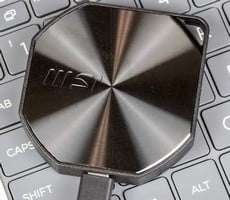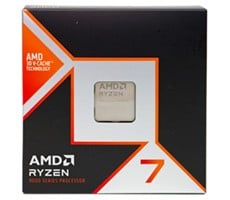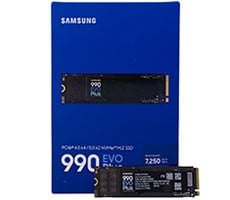Core Ultra 9 285K And Ultra 5 245K Review: Intel Arrow Lake Tested
Intel 800 Series Chipsets For Arrow Lake-S
All of the companion IO available with the existing 700-series chipsets for Raptor Lake returns on the 800 series, but with a few updates. 800-series chipsets, like the flagship Z890 we used for testing, feature up to 20 lanes of PCIe 5.0 connectivity, split into x16 for GPU (or x8-x4-x4) and x4 lanes for M.2 storage. The chipset also includes 4 additional lanes of PCIe 4.0 — totaling 24 total lanes — for an extra slot or M.2 port hanging off the chipset itself.
Arrow Lake-S and the 800-series chipsets also usher in support for CU-DIMMs, or Clocked Unbuffered Dual In-line Memory Modules. CU-DIMMs are similar to standard DDR5 DIMMs, and use the same DIMM slots in fact, but feature an on-PCB clock driver (CKD) that generates the clock signal used by the memory, thus preventing the need to sync off-module. As such, CU-DIMMs offer improved signal integrity, which in turn results in better stability at higher frequencies. With the Core Ultra 200S series, using CU-DIMMs results in a default JEDEC speed of 6400MT/s, versus the default 5600MT/s when using standard DDR5 DIMMs.
The MSI MEG Z890 ACE Motherboard
MSI, alongside many of Intel’s other partners, has a wide array of motherboards coming down the pipeline for Arrow Lake-S Core Ultra 200S series processors. For the purposes of this review, we were set up with one of MSI’s MEG Z890 ACE boards. This model exists within MSI's high-end MSI Enthusiast Gaming (MEG) range, but is still a relatively reasonably-priced offering in comparison to the top of the range models that can top four-digits USD. The MEG Z890 ACE should land at around half of that, making it still quite a pricey motherboard in absolute terms.The MSI MEG Z890 ACE is loaded with goodies and quality-of-life improvements, including all of the features inherent to the Intel Z890 chipset and then some. MSI adds additional functionality through third-party controllers and MSI’s own design initiatives. Some of the handiest features on this board include a simple push-button locking mechanism for the PEG slot and completely tool-less M.2 SSD installation options.
The MEG Z890 ACE has accent lighting, metal reinforcement on its expansion slots and a heavy-duty backplate to add rigidity. It also sports beefy cooling for its multiple M.2 slots, chipset and VRM, and an extremely robust 24+2+1+1 phase >110A digital power solution backed by dual 8-pin EPS12V power feeds and dual supplemental PCIe 6-pin inputs around the board, one of which is required to enable 65W USB Power Delivery on the rear ports. The MEG Z890 ACE features an array of durable Titanium chokes in addition to high-conductivity polymer and / or solid capacitors throughout, making this mode well-suited for extreme overclocking..
Like virtually all of MSI’s recent motherboard products, the MEG Z890 ACE also features a mouse-friendly BIOS / UEFI with a GUI that’s easy to navigate and which offers a ton of overclocking and performance-related options. MSI calls it a Click BIOS, and it sports everything from illustrated menus to the latest version of MSI’s hardware monitor functionality. The UX on MSI’s Z890 ACE BIOS is much denser than previous offerings, and packs in an extensive array of options.
The MSI MEG Z890 ACE also offers simplified overclocking by way of its EZ OC feature, but the UEFI is outfitted with all of the overclocking-related options we’ve come to expect from MSI for manual tweaking as well. The fan controls on the board are quite robust too, and MSI has put in additional effort to isolate the memory circuitry to ensure maximum compatibility, clean signaling, and the highest possible frequencies. The official spec lists these frequencies, depending on the number of DIMMs being used per channel:
- 1DPC 1R Max speed up to 9200+ MT/s
- 1DPC 2R Max speed up to 7200+ MT/s
- 2DPC 1R Max speed up to 4800+ MT/s
- 2DPC 2R Max speed up to 4800+ MT/s
Other features of the MEG Z890 ACE include five M.2 slots (all with coolers) two PCIe Gen 5 x16 slots (x16, or x8/x8), one Gen 4 slot (x4), three USB Type-C ports (one 20G and two 10G), fully eleven USB Type-A 10G ports on the rear panel, an additional eight USB ports using front panel headers, built in Intel 802.11be Wi-Fi 7 with Bluetooth 5.3, Marvell 10-Gigabit Ethernet, an on-board POST-code error reporter, and a whole pile of other features from a list too long to complete here.
After fumbling around with poorly fitting heatsinks on some other motherboards, we’re especially fond of the tool-less quick-release for the M.2 heatsinks and slots. Pop off the heatsinks, insert a drive, lock it in place, snap the heatsink back on, and you’re ready to rock – no tools required. MSI makes setting up the Z890 ACE very user friendly, and this makes it particularly well-suited for test-bench use, as well, considering the on-board power, reset, and CMOS reset buttons.
We should also point out that the MSI MEG Z890 ACE offers 7.1-channel audio with EMI shielding and high-quality audio filtering caps designed to maximize the output quality of the ALC4082 Codec and ESS9219Q Combo DAC/HPA. MSI also includes a handful of goodies in the box, like cable ties, RGB extension cords, SATA cables, M.2 quick-release clips, and a USB thumb drive with drivers and utility software. Copious headers encircle the board for additional USB ports, SATA, RGB lighting, fans/pumps, and even voltage test points to monitor voltage levels using a multimeter.
G.SKILL Trident Z5 CK CU-DIMMs
We also want to show you the memory we used for testing. We installed a 48GB G.SKILL TridentZ5 ZK CU-DIMM memory kit into our test rig, model F5-8200C4052G24GX2-TZ5K.This kit consists of two matching 24GB sticks of memory, for a grand total of 48GB when configured in a dual-channel setup. It’s important to note that for optimal performance, the Core Ultra 200S series should be run with only two sticks of memory. When fully populating all four memory slots on the motherboard, the officially-supported maximum memory frequency will decrease depending on the type of RAM being used (DIMMs or CU-DIMMs). That said, the Core Ultra 200S series is capable of running at much higher memory clocks than previous Intel platforms, especially when using newer CU-DIMMs. In fact, this kit will run at 8,200MT/s by simply enabling XMP.
This G.SKILL memory is capable of running at 8,200MT/s with 40-52-52-131 timings at 1.4v. In comparison to lower clocked standard DDR5, those timings may seem slow, but we are still in the early days of CU-DIMM availability. Over time, timings should get tighter on high-speed kits like this. For now though, there is a latency penalty for running such high-clocked RAM.
In addition, the sticks feature stylized piano-black heat spreaders, and they support Intel XMP 3.0. Tweak a single option in the system BIOS, and this kit will run at its optimal frequency and timings with minimal effort. Throughout our testing this memory was rock-solid and stable, whether operating at DDR5-6400 defaults or at its maximum rated speed and timings.













